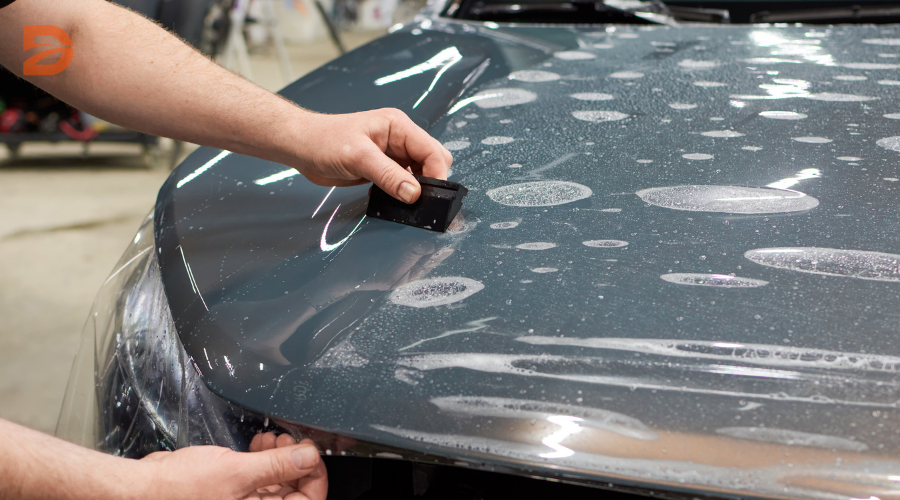Imagine a car that can diagnose and repair its minor issues in real-time, eliminating the need for frequent trips to the mechanic. This remarkable concept is no longer confined to the realms of science fiction, as the automotive industry is on the cusp of a game-changing transformation driven by the integration of cutting-edge technologies, including artificial intelligence (AI) and self-healing materials. The future of car maintenance is poised to undergo a radical shift, with the promise of enhanced efficiency, reduced downtime, and a more seamless driving experience.
Key Takeaways
- Self-healing car materials have the ability to automatically repair minor damages, reducing the need for costly and time-consuming repairs.
- Innovative technologies, such as polymeric composites, nanocomposites, and shape memory alloys, are enabling the development of self-repairing automotive components.
- Biomimetic materials that mimic natural self-healing processes are being explored to further enhance the self-repair capabilities of vehicles.
- The integration of AI and machine learning in automotive systems is paving the way for intelligent, self-aware vehicles that can diagnose and address issues autonomously.
- The future of automotive innovation is poised to revolutionize the car ownership experience, making it more convenient, cost-effective, and environmentally friendly.
Unveiling the Marvels of Self-Healing Cars
The automotive industry is witnessing a remarkable transformation with the emergence of self-healing cars. These innovative vehicles are equipped with the power of self-healing materials, which have the remarkable ability to detect and repair minor damages, such as scratches or cracks, without the need for manual intervention. This cutting-edge technology is poised to revolutionize the way we think about vehicle maintenance and durability.
Understanding Self-Healing Materials
At the heart of self-healing cars are smart materials that possess the inherent capability to sense and respond to their environment. Polymeric composites and nanocomposites are examples of these remarkable materials, which can autonomously detect and heal minor imperfections, restoring the original structural integrity. Additionally, shape memory alloys and intelligent coatings are also being explored for their potential to enable self-repair capabilities in vehicles.
Applications in Automotive Coatings
One of the most promising applications of self-healing materials in the automotive industry is in the realm of coatings. These specialized coatings can automatically heal minor scratches or chips, preserving the vehicle’s aesthetic appeal and protecting the underlying structure. By incorporating self-healing properties, automakers can offer increased durability and reduced maintenance costs for their customers, enhancing the overall driving experience.
“The ability of self-healing materials to automatically repair damage is a game-changer in the automotive industry, paving the way for more resilient and low-maintenance vehicles.”
As the demand for sustainable and technologically advanced vehicles continues to grow, the development of self-healing car materials promises to be a crucial driver of innovation in the years to come.
Self-healing car materials, smart materials: The Future of Automotive Innovation
The development of self-healing car materials and smart materials is a clear indication of the future of automotive innovation. These advanced materials have the potential to revolutionize the way we maintain and repair vehicles, leading to a more efficient, sustainable, and cost-effective transportation system.
By incorporating self-healing and responsive capabilities, cars can become more resilient, requiring fewer repairs and reducing the environmental impact associated with traditional maintenance practices. The integration of these innovative materials is a significant step towards the future of intelligent, self-aware vehicles that can adapt and maintain themselves, ushering in a new era of transportation.
Self-healing materials can typically repair damage within a few minutes to a few hours, depending on the type of material used. Vascular channels in these materials can hold repair compounds in 1D, 2D, or 3D formats and can be connected to an external tank for a continuous supply of repair liquid, extending the self-healing functionality.
Intrinsically self-healing materials can attain their original shape through external energies like heat, light, or by their inherent nature, providing almost infinite self-healing behavior, given the right conditions.
| Feature | Benefit |
|---|---|
| Self-healing paints and protective coatings | Prevent corrosion by quickly repairing any damage on the surface, safeguarding the metal from potential corrosion effects. |
| Components repaired using self-healing materials | Can restore their original resistance as though glue or solder had been applied between them. |
| Shape Memory Alloys (SMAs) | Used in various automotive applications, including structural components, safety systems, and actuators for active aerodynamics tools. |
The market already offers self-healing materials in some applications, with potentially unlimited applications for this technology, promising significant advancements in various industries, including the automotive sector.
“The integration of self-healing and smart materials in cars will usher in a new era of intelligent, self-aware vehicles that can adapt and maintain themselves, revolutionizing the future of transportation.”
Cutting-Edge Technologies Enabling Self-Repair
The development of self-healing car materials is made possible by innovative technologies in the realm of advanced materials. Polymeric composites and nanocomposites are examples of smart materials that can exhibit self-healing properties. These materials are designed to detect and repair minor damages, such as cracks or scratches, through various mechanisms, including the release of healing agents or the activation of specialized microstructures.
Polymeric Composites and Nanocomposites
Nanoparticles like silica, titania, and zinc oxide are commonly used in self-healing car paints to enhance their protective properties, improving hardness, adhesion, and resistance to UV radiation, scratches, and chemicals. The self-healing mechanism in these paints is temperature and time-dependent, with higher temperatures accelerating the healing process by making the healing agent more fluid and allowing it to flow into the damaged area more easily.
Shape Memory Alloys and Intelligent Coatings
Similarly, shape memory alloys and intelligent coatings are being explored for their potential to enable self-repair capabilities in vehicles. These innovative technologies are paving the way for a future where cars can autonomously diagnose and repair themselves, reducing maintenance costs and downtime for owners. While severe scratches or deep damage might not be fully repairable through the self-healing mechanism alone, these self-repairing technologies and advanced materials offer significant benefits in enhancing the durability and longevity of automotive polymeric composites and nanocomposites.
Exploring the Potential of Biomimetic Materials
The automotive industry is abuzz with excitement over the prospect of self-healing car materials, and a key aspect of this innovation is the exploration of biomimetic materials. These materials are inspired by the remarkable self-repair mechanisms observed in nature, offering a promising path towards even more sophisticated and efficient self-healing solutions.
By studying and mimicking the strategies employed by living organisms, researchers are developing innovative materials that can replicate these natural self-repair mechanisms. From the regenerative abilities of certain plants and animals to the adaptive properties of various natural structures, the biomimetic approach has the potential to revolutionize the way we think about sustainable and intelligent automotive design.
One such example is the use of shape memory alloys (SMAs), which are metals that can return to their original shape after being deformed by applying heat or electricity. These adaptive materials enable the creation of intelligent components that can adjust to changing conditions, enhancing the performance and safety of vehicles.
| Biomimetic Material | Automotive Application | Key Benefit |
|---|---|---|
| Electrochromic glass | Smart windows | Regulates light and heat for improved energy efficiency |
| Piezoelectric materials | Smart sensors and actuators | Monitors and controls vehicle components |
| Thermoelectric materials | Smart cooling and heating systems | Enhances comfort and performance |
These innovative biomimetic materials, inspired by the incredible adaptability and resilience found in nature, are poised to redefine the future of sustainable and intelligent automotive design. As researchers continue to explore the potential of these nature-inspired solutions, the automotive industry is on the cusp of an exciting new era of advanced materials and sustainable innovation.
Conclusion: Embracing the Era of Intelligent Vehicles
The development of self-healing car materials and smart materials represents a significant stride towards the future of automotive innovation. By integrating these advanced materials and technologies, vehicles can become more resilient, self-aware, and capable of autonomously diagnosing and repairing minor issues. This shift towards intelligent vehicles holds the potential to transform the transportation industry, leading to increased efficiency, reduced maintenance costs, and a more sustainable approach to mobility.
As the industry embraces this technological revolution, the future of self-healing cars promises to deliver a glimpse into a world where vehicles can adapt and maintain themselves, ushering in a new era of intelligent and responsive transportation. With the anticipated advancements in autonomous vehicle (AV) technology, the AV market is poised to reach staggering heights, with estimates suggesting a potential $1 trillion market by 2030 and $3 trillion by 2040.
By embracing the era of intelligent vehicles, we can unlock a future where cars not only serve as reliable modes of transportation but also adapt to our needs, minimize environmental impact, and redefine the way we interact with our surroundings. As the industry continues to invest in self-healing car materials and smart technologies, the possibilities for a more resilient, efficient, and sustainable transportation ecosystem become increasingly tangible, paving the way for a future where intelligent vehicles are the norm rather than the exception.
FAQ
What are self-healing car materials?
Self-healing car materials are advanced materials capable of automatically detecting and repairing minor damages, such as scratches or cracks, without the need for manual intervention. These materials can exhibit self-healing properties through various mechanisms, including the release of healing agents or the activation of specialized microstructures.
What are some examples of smart materials used in automotive applications?
Examples of smart materials used in automotive applications include polymeric composites, nanocomposites, shape memory alloys, and intelligent coatings. These materials can exhibit self-healing capabilities, enabling cars to become more resilient and adaptable.
How can self-healing car materials revolutionize the automotive industry?
The integration of self-healing car materials and smart materials has the potential to revolutionize the automotive industry by making vehicles more resilient, reducing maintenance costs, and increasing efficiency. These advanced materials can enable cars to autonomously diagnose and repair minor issues, leading to a more sustainable and cost-effective transportation system.
What technologies are enabling the development of self-healing car materials?
The development of self-healing car materials is made possible by cutting-edge technologies in the field of advanced materials, including polymeric composites, nanocomposites, shape memory alloys, and intelligent coatings. These innovative materials are designed to detect and repair damages through various mechanisms, paving the way for a future of self-aware and self-repairing vehicles.
How are biomimetic materials influencing the development of self-healing car materials?
The exploration of biomimetic materials, which are inspired by the remarkable self-healing abilities observed in nature, is influencing the development of self-healing car materials. By studying and mimicking the strategies employed by living organisms, researchers are developing innovative materials that can replicate these natural self-repair mechanisms, leading to even more sophisticated and efficient self-healing solutions for the automotive industry.











